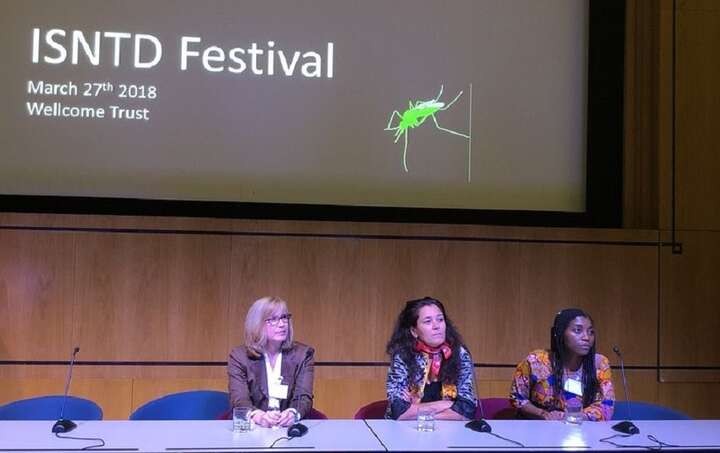
By Pamela Bongkiyung
Science communication has been garnering attention of recent and in a very positive way. There is a renewed focus on communicating its intricacies and complexities to a non-specialist audience so that society remains informed. It is against this backdrop that the International Society for Neglected Tropical Diseases (ISNTD) organised this festival bringing together organisations from the creative arts and global health communities to explore various ways to enable transformative change in discussing neglected tropical diseases (NTDs). Imran Khan, the Head of Public Engagement at the Wellcome Trust kickstarted the event with the connection of science and society , raising a clarion call to communicate research with emotion, given that how people think and feel is just as important as what they know.
Improving engagement with patients or research end-users’ by keeping them at the heart of creativity was a theme illustrated through the works of McCann Global Health, who use commercials to drive demand for health; using corporate & social language, narratives and family stories to communicate strong public health messages. For some, using virtual observations to ensure medication adherence for successful treatment results is becoming the norm for patients as shown by the Behavioural Insights Team.
The importance of providing context to information was presented by the Institute of Development Studies who created a platform during the Ebola outbreak in Sierra Leone and Liberia in 2013/2014 to inject context in discussions relating to the situation. The group brought together anthropologists who looked at concerns through the local prism and not from reports published by the international media which most times was not reflective of concerns by locals on the ground. Important of all, was the realisation of the necessity to build data that can create a link between the grassroots and policymakers, advocated by Margaret Olele of the American Business Council. How can you translate the nuances of culture to connect the people, Margaret asked?
But challenges do exist in communicating about global health. We should be maximising all available media platforms to amplify messages, advocated Alan Tennenberg, Chief Medical officer at Johnson & Johnson. The company is becoming a partner of choice to head soil-transmitted--helminths elimination campaigns and they work with multiple partners across sectors to realise their strategies and desired impact.
IBM through their corporate social responsibility programme is using their in-house design thinking to bridge communication gaps. It encourages observing, reflecting and repetition ensuring that community stays at the heart of science. This message was echoed by The Mentor Initiative who are first responders when disasters strike and stay on long after other NGOs have left; to build capacity through engaged communication of the science using various methods.
It was great to learn that the Japan Global Health Innovative Technology (GHIT) is taking great strides to join the NTDs world in an innovation and drug research capacity, with an awareness of what is culturally appropriate for the various places they work in. Claude Oeuvray from The Merck Global Institute was right when he said: ‘when you think global, you have to think of emerging diseases.’
The workshops that followed centred rightly on taking the science to the people with highlights on the tools and production strategies available. Key messages revolved around creativity in communicating science and public health messages to communities. How to use data for social good came up constantly be it in video story-telling or in how to collect data for easy synthesis.
One of the key workshops was on ‘Writing for Impact’ which was led by Zoe Mullan, the Editor of The Lancet Global Health. Participants of this session had some major takeaways on key things to note when moving from research to publication. Some are highlighted below:
- The mantra in research publication is REWARD which is an acronym for ‘Reduce Research Waste and Reward Diligence)
- Use the Strobe Checklist for observational studies
- Research should tell a story and their titles should be informative and concise
- Abstracts are very important as they are the first thing that editors read. State the aim of the research prominently by responding to the question: why am I doing this work?
You can find more tips here.
Looking at the road ahead and embedding lessons learned, Lisa Russell who is a film director advocated the need to change the narrative of global health and make story-telling responsible, not just about soundbites, as there are people behind the stories who appreciate their stories not defining what they become in the future. COUNTDOWN’s approach to dismantling big scientific concepts in a changing communication science landscape was presented by myself. It provided an insight on balancing our act whilst communicating science to inform, educate and empower the communities in which we work and ourselves. It called for science communication to move beyond passive communication of messages but push for a more transformative outcome in the lives of those these messages touched.
Many attending the festival admitted to being struck by a new thought as the day progressed. Jamie Guth from Global Health Connections was right when she emphasised the post-truth era in global health. She advocated for science communications moving beyond evidence as evidence remains only one component of persuasion. She called on all to consider using Aristotle’s art of persuasion which incorporates ‘logos, ethos and pathos’.
To understand the changing demands on science communications professionals further, you can read this report from a recently attended workshop organised by STEMPRA.
Share your experiences working in this sector in the comment section and join us on social media for further interactions.
Tweet us: @NTDCOUNTDOWN @NTDGHCOUNTDOWN @COUNTDOWNNTDCAM
